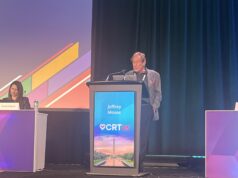
Two drug regimens involving low doses of rivaroxaban (Xarelto, Bayer)—one with a 15mg once daily dose of the drug and a P2Y12 inhibitor and another with a 2.5mg twice daily dose and dual antiplatelet therapy—are associated with lower rates of clinically significant bleeding in patients with atrial fibrillation who have undergone percutaneous coronary intervention (PCI) than is a standard triple therapy drug regimen (dual antiplatelet therapy plus warfarin). Furthermore, these two regimens are associated with a significantly reduced risk of all-cause mortality or recurrent hospitalisation.
Writing in The New England Journal of Medicine, Michael Gibson (Cardiovascular Division, Department of Medicine, Beth Israel Deaconess Medical Center, Harvard Medical School, Boston, USA) and others report that treatment strategies for patients with atrial fibrillation who have undergone PCI “must balance the risk of stent thrombosis and ischaemic stroke with the risk of bleeding”. They add that a “common guideline-supported practice” is combined anticoagulation (with warfarin) and dual antiplatelet therapy (ie. triple therapy) but note “this approach may result in excessive major bleeding”. Therefore, given the non-vitamin K antagonist rivaroxaban is associated with lower rates of intracranial bleeding (but similar rates of major bleeding) than warfarin, Gibson et al evaluated the safety and efficacy of the drug in PCI patients with atrial fibrillation.
In PIONEER AF-PCI, 2,124 PCI patients with non-valvular atrial fibrillation were randomised to receive 15mg once daily rivaroxaban and a P2Y12 inhibitor for 12 months (709; group one), 2.5mg twice daily rivaroxaban and dual antiplatelet therapy (709; group two), or standard triple therapy (dual antiplatelet therapy plus warfarin; 706; group three). Prior to randomisation, intended duration of dual antiplatelet therapy was determined by patient characteristics. Of those in group two, 109 had been assigned to one month duration of dual antiplatelet therapy (DAPT), 248 to six months’ DAPT, and 352 to 12 months’ DAPT. In group three, the respective numbers were 115, 246, and 345. The primary safety outcome was clinically significant bleeding—a composite of major or minor bleeding according to the thrombolysis in myocardial infarction (TIMI) criteria or bleeding acquiring medical attention. The efficacy endpoints (secondary) included major adverse cardiovascular events.
At 12 months, the primary safety endpoint occurred in groups one and two significantly less frequently than it did in group three: 16.8% and 18% vs. 26.7%, respectively (p<0.001 in both comparisons). Gibson et al comment: “Both groups receiving rivaroxaban had significantly lower rates of bleeding requiring medical attention than did the group receiving standard therapy across all strata of DAPT duration (hazard ratio for group one vs. group three, 0.61; p<0.001. Hazard ratio for group two vs. group three, 0.67; p=0.002).” That only 22% of patients on triple therapy received DAPT for one year, according to the authors, may have “made it more difficult to show a reduction in the rate of bleeding with rivaroxaban strategies” but they add this “is more reflective of current clinical practice.”
There were no significant differences in the rate of major adverse cardiovascular events between groups, but Gibson et al note “the observed broad confidence intervals diminish the surety of any conclusions regarding efficacy”. Furthermore, in a separate post-hoc analysis (published in Circulation), the investigators found that groups one and two had significantly lower rates of all-cause mortality and recurrent hospitalisation than group three: 34.9% and 31.9% vs. 41.9% (p=0.008 and p=0.002 for the comparisons). In this paper, they comment: “The results of the present analysis add to and strengthen the primary results of the study and demonstrate that the reduction in bleeding and efficacy events was clinically meaningful insofar as it often resulted in fewer hospitalisations in these patients.”
In accompanying commentary to the post-hoc analysis, in Circulation, Deepak Bhatt (Brigham and Women’s Hospital Heart & Vascular Center, Boston, USA) notes that clopidogrel was the “predominant PY12 inhibitor” used in PIONEER and “further study is necessary to understand fully how to integrate non-vitamin K antagonist use with prasugrel (Efient, Daiichi Sankyo) and ticagrelor (Brilinta, AstraZeneca). He adds that ongoing studies are reviewing the use of other non-vitamin K antagonists, such as dabigatran (Pradaxa, Boehringer Ingelheim) in atrial fibrillation patients undergoing PCI and says: “However, if there is no substantial heterogeneity, perhaps pooling the data may provide further clarity about the optimal antithrombotic cocktail. For the time being, in patients not in clinical trials, full dose oral triple therapy with dual antiplatelet agents and full-dose anticoagulation should be avoided as a routine practice.”
Gibson told Cardiovascular News: “PIONEER now provides data that clinicians can use in deciding the optimal regimen to balance safety and effectiveness.”
Both the primary results and the post-hoc analysis results of PIONEER were presented at late-breaking trial session at the American Heart Association (AHA) scientific sessions (12–16 November, New Orleans, USA)













